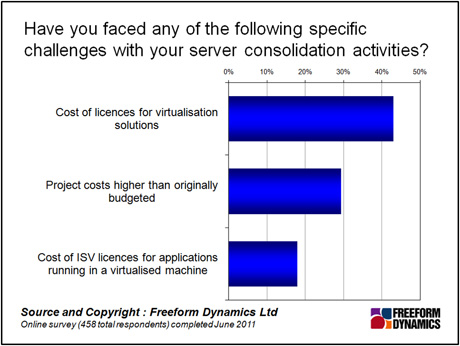For much of the last three years x86 server virtualisation has been highly visible in many enterprise consolidation projects. Indeed, our research amongst real users demonstrates that whilst the use of x86 server virtualisation is extending, operational experience is highlighting challenges that need to be addressed to smooth the greater exploitation of the technologies.
The research has highlighted that whilst a large proportion of organisations are now comfortable with the primary use cases established for virtualised x86 servers, such as consolidation of file and print servers etc., there remain considerable numbers, especially in smaller businesses, that have yet to deploy server virtualisation. That said, research shows that usage is very likely to increase in organisations of all sizes.

It is interesting to note that whilst the primary usage cases are widely appreciated, it is also clear that those who have begun to scale up implementations perceive there to be even wider potential usage areas than those yet to start.
It should also be noted that our research illustrates that as organisations use server virtualisation more widely, “real world” operational experiences are beginning to highlight a number of challenges that need to be addressed. Typical challenges reported include the need for effective tools to be available to manage extensive numbers of virtual servers, good working practice to be established and a need to improve the consolidation ratios achieved.
Many organisations state that staff ‘overstretch’ is now a major worry especially as the stress to patch and maintain virtualised servers grows. This makes the most obvious of the operational challenges, namely the management of virtualised systems, an area to be addressed quickly to enable further adoption of virtual servers. IT professionals report they are less than overjoyed with the range of tools they have available to help them in their routine administration of such systems.
IT staff continue to be faced with little time to move resources to projects that deliver additional value to the business. The need for effective management tools and operational processes is further reinforced as it is now reported that virtual machine sprawl has become as much of a challenge, if not larger, as the physical machine sprawl of earlier operations.
Another issue is that many of the businesses cases used for initial large scale rollouts have not delivered quite as much benefit as anticipated. Examples frequently cited are that the server consolidation ratios promised have often not been achieved and this is putting hurdles to further roll out plans. It is not unusual for vendors to cite potential consolidation ratios of 20:1, 30:1, or 40:1 while our research tells us that most people are actually achieving consolidation ratios of between 5:1 and 10:1. Ratios of 5:1 and 10:1 are still extremely valuable and worth making, but it does help if the approvals board know this up front so that post project analyses do not highlight this saving as a form of failure. We expect that this particular hurdle will be overcome as experience increases and good practice is established.

As can be seen from the figure above, the cost of licenses for the server virtualisation software itself was highlighted by almost half of those surveyed as a specific challenge. As virtualisation usage increases, software licensing is an area few vendors are willing to recognise as an inhibitor to widespread adoption. It is only fair to mention that few organisations do a good job of managing their software licenses effectively even in non-virtualised environments. Altogether if CIOs, IT managers and vendors work together making software licensing easier to manage proactively, all parties will benefit.
There is no doubt server virtualisation is valuable and will be utilised ever more widely. Equally, it is becoming clear that initial pilot projects do not always lead smoothly to larger scale implementations. While the business benefits of virtualisation are significant, the success of broader deployments is directly dependent on sound planning and good operational management.
The areas of management and software licensing must be addressed very carefully by CIOs and software vendors alike if organisations are to make best use of virtualisation going forward. There is considerable potential yet to be exploited as things scale up and move beyond consolidation, with even greater business benefit to be reaped. Going forward, it all becomes about management and this remains an immature area where CIOs need to tread carefully and be ready to invest.
CLICK HERE TO VIEW ORIGINAL PUBLISHED ON
